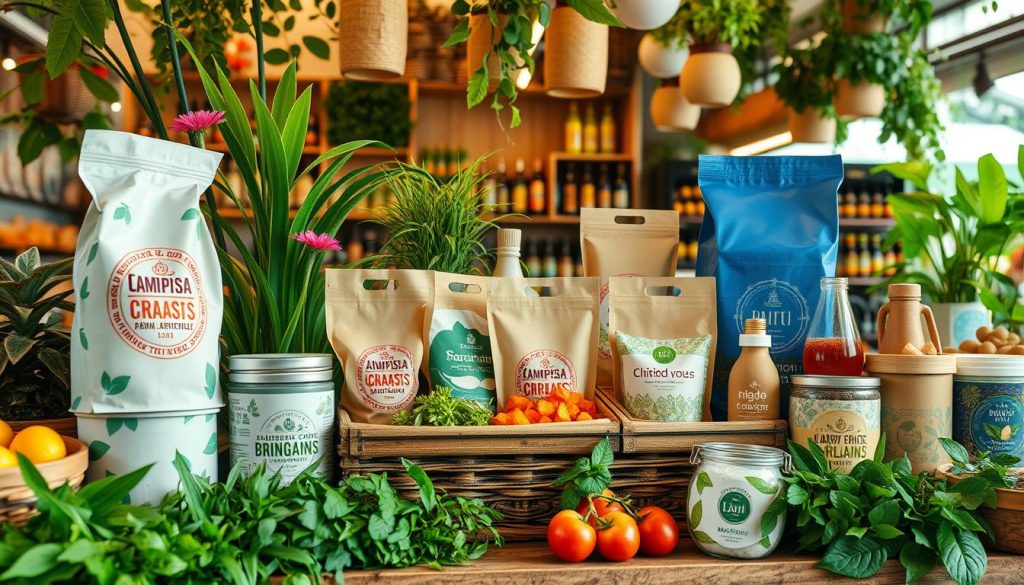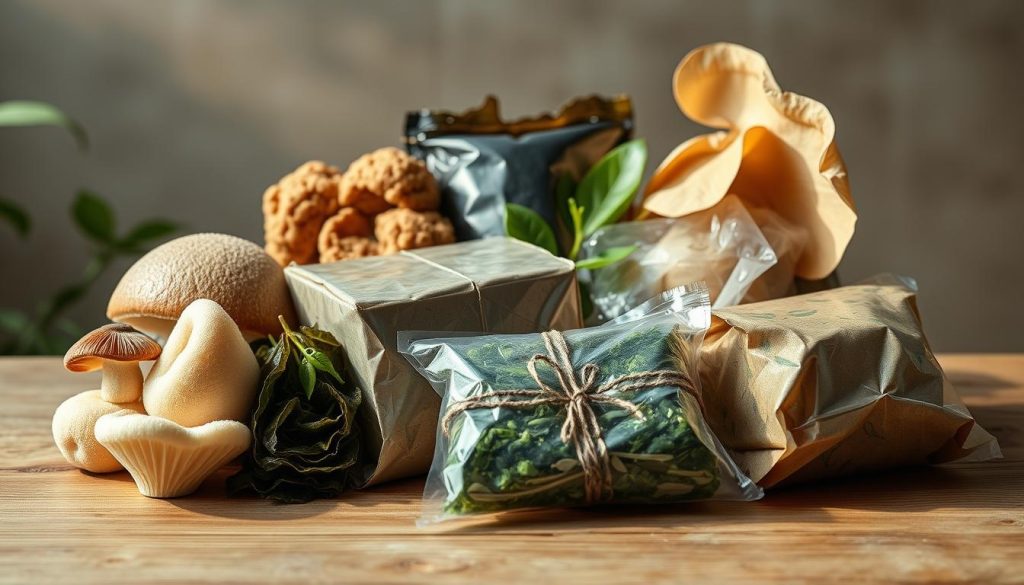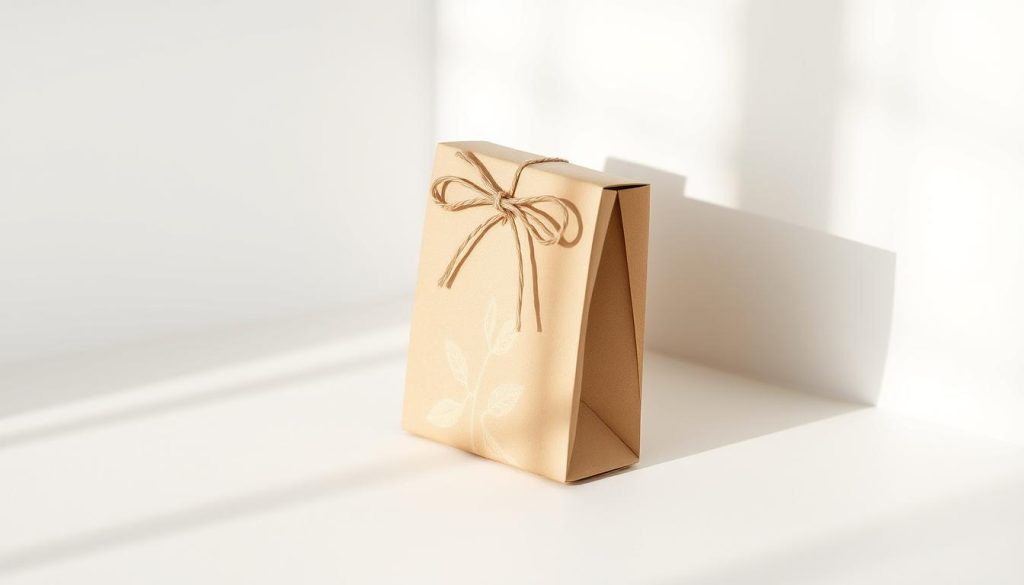I’ve seen a big change in packaging lately. It’s all about using less waste. As someone who buys things, I’m happy to see more eco-friendly options. These choices are more than just a trend; they’re crucial for our planet’s future.
In this article, we’ll look into low-waste packaging. We’ll see why it’s important and how it’s helping. We’ll talk about new materials and simple designs. Whether you shop a lot or run a business, you’ll learn how to cut down on waste.
Let’s start this journey together. We’ll see how small changes in packaging can make a big difference. It’s time to explore the power of sustainable packaging solutions!
Understanding the Impact of Traditional Packaging on the Environment
I’ve been looking into how traditional packaging affects our planet. The results are scary. It’s vital to find ways to reduce packaging waste.
Statistics on Global Packaging Waste
Our packaging habits are harming the environment a lot. Here are some shocking numbers:
| Region | Annual Packaging Waste (Million Tons) | Recycling Rate (%) |
|---|---|---|
| North America | 80 | 28 |
| Europe | 78 | 42 |
| Asia | 141 | 22 |
Environmental Consequences of Excessive Packaging
The waste from packaging is causing big problems. Landfills are full, oceans are polluted, and animals are in danger. Making packaging also releases a lot of greenhouse gases, which speeds up climate change.
The Urgency for Sustainable Alternatives
We need to act quickly. Eco-friendly packaging is now essential. Companies are starting to use green packaging solutions.
As consumers, we can push for change. Support brands that use sustainable packaging. Demand better from others too.
What is Low-Waste Packaging?
Low-waste packaging is changing the game in product containment. It’s making big waves in industries and how we shop. This method cuts down on waste by using less material and choosing eco-friendly options.
At its heart, low-waste packaging focuses on minimal design. It removes unnecessary parts, keeping only what’s essential. It’s not just about using less; it’s about designing smartly to protect products and the environment.
Reusable packaging is a big part of it too. These designs are made to be used over and over. From refillable containers to items that change form, the options are vast.
Let’s look at the main types of low-waste packaging:
- Minimal designs that reduce material use
- Reusable containers and bags
- Biodegradable or compostable materials
- Packaging made from recycled content
- Multi-functional packaging that serves a purpose after use
| Packaging Type | Waste Reduction | Consumer Appeal |
|---|---|---|
| Minimal Design | High | Moderate |
| Reusable Solutions | Very High | High |
| Biodegradable Materials | Moderate | High |
Brands can greatly reduce their environmental impact by using these strategies. They often save money and win over eco-aware customers. It’s good for businesses and the planet.
The Rise of Sustainable Packaging in Consumer Goods

I’ve seen a big change in how companies package their products. More brands are using eco-friendly containers and zero-waste packaging. This change is due to what shoppers want, what companies are doing, and new government rules.
Shifting Consumer Preferences
More people, like me, are caring about the environment. We want products in packaging that’s good for the planet. This is making companies think differently about how they package their goods.
Brand Initiatives in Eco-Friendly Packaging
Big brands are now using eco-friendly containers. For example, Coca-Cola is testing paper bottles, and Procter & Gamble has introduced refillable shampoo bottles. These moves are changing how we shop and use products.
Government Regulations Driving Change
Laws are also pushing for better packaging. In California, a new rule says all packaging must be recyclable or compostable by 2032. This is forcing companies to find new, planet-friendly ways to package their goods.
| Driver | Impact on Sustainable Packaging |
|---|---|
| Consumer Demand | Increased interest in eco-friendly products |
| Brand Initiatives | Development of innovative packaging solutions |
| Government Regulations | Mandatory shift towards recyclable/compostable packaging |
This move towards sustainable packaging is changing how we shop and use products. It’s exciting to see how these changes are helping to cut down on waste and protect our environment.
Innovative Materials in Low-Waste Packaging

I’ve noticed a big change in packaging that’s better for our planet. New materials are leading the way to a greener future. Let’s look at some of these exciting materials that are changing packaging.
Mushroom packaging is a big deal. It’s made from waste and mycelium, and it breaks down easily. Companies are using it to cut down on plastic waste.
Seaweed-based packaging is also making waves. It can dissolve in water, leaving nothing behind. It’s great for things like sauce packets or coffee pods.
Plant-based plastics are becoming more popular. They’re made from corn or sugarcane and are better for the environment. They also break down faster, helping to reduce landfill waste.
- Stone paper: Made from calcium carbonate, it’s water-resistant and tree-free
- Edible packaging: Created from milk proteins or seaweed, it’s safe to consume
- Bamboo packaging: Rapidly renewable and naturally antimicrobial
The move towards green packaging is clear. Brands are choosing eco-friendly options to please customers and follow rules. While there are still costs and challenges, the benefits are huge. As technology gets better, we’ll see even more new packaging ideas.
Minimal Packaging Design: Less is More

Minimal packaging design is changing how we see product presentation. I’ve noticed a trend towards simpler packaging that’s both efficient and beautiful. This method reduces waste and makes products stand out.
Principles of Minimalist Packaging
Minimal packaging design uses less material but keeps products safe. It focuses on what’s truly needed. This often means using just one material, making recycling easier and reducing harm to the environment.
Case Studies of Successful Minimal Designs
I’ve seen some amazing examples of minimal packaging. For instance, a toothbrush company sends its product in a small cardboard envelope, ditching plastic. Another example is a cosmetics brand that uses containers you can refill, greatly reducing waste.
Balancing Aesthetics with Functionality
The challenge in minimal packaging is keeping it appealing while using less. Designers are using texture, color, and shape to make packages eye-catching. The goal is to find a balance between looking good and being practical.
| Aspect | Traditional Packaging | Minimal Packaging |
|---|---|---|
| Material Usage | High | Low |
| Waste Generated | Significant | Minimal |
| Recycling Ease | Often Difficult | Usually Simple |
| Visual Impact | Can be Overwhelming | Clean and Focused |
Reusable Packaging Solutions: A Circular Approach
I’ve noticed a big change in how we use packaging. Now, we’re moving towards reusable solutions. These designs help cut down waste and make packaging last longer.
There are many types of reusable packaging. Some companies give out containers for things like shampoo or cleaning products. Others make strong packaging that can be used over and over again. This not only reduces waste but also makes customers happy with rewards or deposit systems.
Circular packaging has more than just environmental benefits. It can also save businesses money on packaging costs. And for consumers, it means cheaper products and the joy of helping the planet. But, starting these systems can be tough. It requires good reverse logistics and durable packaging.
Still, many brands are jumping on the reusable packaging bandwagon. Some grocery stores have bulk sections for customers to fill their own containers. Online shops are testing reusable shipping boxes that can be returned. These steps show how circular packaging can grow in different sectors.
Reusable packaging is key to a greener future. By choosing brands that use these solutions, we help the planet. Together, we can make the economy more circular and protect our world for the next generations.
Biodegradable and Compostable Packaging Materials
I’ve noticed a big change towards eco-friendly packaging. Now, biodegradable materials are more common. They break down easily, which helps reduce waste and harm to the environment.
Understanding Biodegradability vs. Compostability
Biodegradable items can naturally decompose. Compostable ones turn into soil that’s good for plants. Both are good for the planet, but they end up differently.
Popular Biodegradable Materials in Packaging
There are many biodegradable packaging options now. Some include:
- Plant-based plastics (PLA)
- Mushroom packaging
- Seaweed-based materials
- Paper and cardboard
Challenges and Opportunities in Adoption
Biodegradable packaging has many benefits, but there are challenges. Cost and how well they work can be a problem. But, I believe we’ll see big improvements as more people want these options. As demand goes up, prices will likely drop, making them more affordable.
| Material | Biodegradability | Cost | Performance |
|---|---|---|---|
| Plant-based plastics | High | Medium | Good |
| Mushroom packaging | Very High | High | Moderate |
| Seaweed-based materials | Very High | High | Good |
| Paper and cardboard | High | Low | Variable |
Zero-Waste Packaging Initiatives: From Concept to Reality
I’ve noticed a big increase in zero-waste packaging efforts lately. These efforts aim to get rid of waste by changing how we package things. Many companies are now using sustainable packaging to lessen their environmental footprint.
Loop is a great example. It’s a circular shopping platform that works with big brands. They offer products in reusable containers. When customers return empty containers, they get refilled. This method greatly reduces single-use plastics.
Lush Cosmetics is also making waves. They sell “naked” products, which means they come without any packaging. For items that need packaging, they use recycled materials. They also encourage customers to bring their own containers.
The effects of these efforts are huge. Let’s look at some numbers:
| Initiative | Waste Reduction | Customer Adoption |
|---|---|---|
| Loop | 200,000+ plastic containers saved | 10,000+ active users |
| Lush Naked Products | 6 million plastic bottles avoided annually | 35% of sales are package-free |
| Bulk Food Stores | 50% reduction in packaging waste | Growing by 20% annually |
These numbers prove that zero-waste packaging is real and working. As more companies join in, we’re getting closer to a future where sustainable packaging is common, not rare.
Packaging Waste Reduction Strategies for Businesses
Many businesses face the challenge of too much packaging waste. But, there are effective ways to deal with it. By changing how they design packaging, companies can reduce waste and save money. One important step is to make packaging just the right size.
Choosing the right materials is key for less waste. More companies are using recycled or biodegradable options. These choices not only cut down on waste but also attract eco-friendly customers. Some are even looking into new materials like mushroom-based packaging or seaweed.
Improving the supply chain is also vital. I’ve seen businesses team up with suppliers who care about the environment. This partnership leads to less waste in the whole production process. By doing this, companies gain both environmental and financial benefits. It’s a win-win for everyone.

